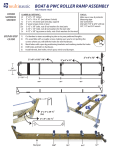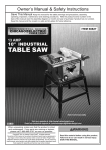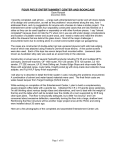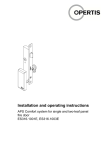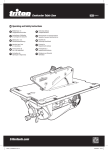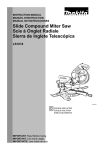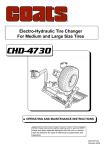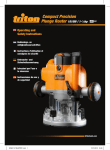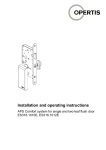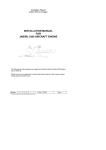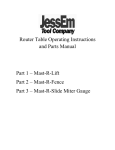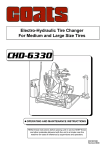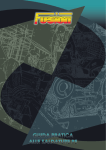Download ASSEMBLY & OPERATING INSTRUCTIONS
Transcript
PTA 001 ASSEMBLY & OPERATING INSTRUCTIONS For instructions on the 184mm saw supplied with this product see page 27. Follow these instructions for correct assembly and operation of this product. When you’ve finished setting up use some scrap material to work your way through the “Accuracy Tests” and “Operation” sections, studying the manual before making the cuts. If lending or passing on this product to someone else, ensure they also study this manual before use. NOTE: “Front of the Saw Table” refers to the end which has the switchbox. The “left-hand & righthand side” are when viewed from the front. CONTENTS PG# Safety 3 Set-Up Removing and Fitting the Legs (B & C) Fitting the Saw Slot Insert (J) Fitting the Trigger Strap (K) Removing the Saw Fitting the Saw Blade (N) Fitting the Rip Fence (D) Fitting the Overhead Guard (H & G) Connecting the Power Fitting the Storage Hooks (L) 4 4 4 5 5 5 6 6 7 7 Features & Functions Rip Fence (D) Protractor (F) Captive Push-Stick and Side Pressure Finger The Overhead Guard (H) 8 8 9 10 12 Accuracy Tests 13 Trouble-shooting / Fine-Tuning Cuts out of square Workpiece jams Adjusting the protractor pointer 15 15 16 16 Operation Basic Ripping Narrow Ripping Ripping Long Pieces Ripping Larger Sheets Double Ripping Planing an Edge Planing a Face Planing a Wide Sheet Edge Rebating Tongue and Grooving Edge Work on Thin Material Working on End-Grain Taper Ripping Cross-Cutting Multiple Cross-Cutting Multiple Cross-Cutting against an End Stop Halving Joints & Tenons Mitre Cutting Mitre Cutting Moulding Mitre Cutting to a Length Stop Cutting Sharp Points or Wedges 17 17 17 17 18 18 18 19 19 19 20 20 20 21 22 22 Optional Accessories Bevel Ripping Guide Wheel Kit Router Kit Mini Sliding Extension Table Dust Bag & Collector 25 25 25 26 26 26 184mm Saw Instructions Saw Safety Saw Features and Functions Fitting & Removing the Saw Blade Adjusting Cut Depth Bevel Adjustment 90˚ Check Power Switch Sighting the Cut Line Saw Operation Hand-Held Operation Ripping Saw Maintenance 27 28 29 29 29 30 29 30 31 31 31 31 32 PARTS LAYOUT B Rear Legs (packed in Main Body) C Front Legs (packed inside Rear Legs) E Captive Push-stick F Protractor (with Side Pressure Finger) D Rip Fence J Saw Slot Insert A Main Body L Storage Hooks 22 23 23 24 24 25 H Overhead Guard G Overhead Guard Support I 184mm Power Saw (fitted to Main Body) N Blade (packed separately) Page 2 K Trigger Strap SAFETY - Observe the following rules at all times for safe, accurate work. 1. Never operate the saw hand-held while the Trigger Strap (K) is fitted. To avoid the potential for personal injury ensure the trigger strap is removed before using the saw hand-held. down to 80mm, removing 10mm. You could set the fence at 7.5mm (allowing for a 2.5mm saw cut), but you would be creating an uncontrolled narrow offcut trapped between the blade and the fence, and it could be flung out towards you. 2. Always keep fingers well clear of the blade. Fit the overhead guard as low as possible, to just allow the work to pass beneath. Make sure fingers and thumbs are tucked in, and will not pass near the blade even if the wood kicks or your hands slip. It’s easier, safer and more accurate to set the fence to your desired size (80mm) and keep good control of it, allowing the offcut to fall harmlessly aside. 8. Always have the saw blade as low as possible. You’ll get best results if you work with a lowered saw blade. It is safer, and gives a smoother, less splintered cut. You can also improve the quality of your cuts by ripping slightly oversize (say 1 mm more than you need) then re-setting the fence by 1 mm and making a finishing cut. 3. Never reach over or behind a spinning blade. Most table saw accidents occur when operators reach over an unguarded or poorly guarded blade to remove off-cuts. Always use a stick to flick offcuts away, or preferably, switch off and wait until the blade has stopped spinning. 4. Always use the safety guard when ripping. The blade can lift the wood up and fling it towards you with great force if the guard is not fitted. Do not stand directly in line with the blade, and keep the guard lowered so that the two anti-kickback pressure fingers hold the work down on the table. 9. Always set the fence parallel to the blade, and lock it securely at both ends. You must never angle the fence to the blade. Your wood will jam between the blade and the fence, and could be flung out towards you. 10. Always prevent narrow off-cuts jamming in the blade slot. Avoid creating thin off-cuts (say around 1-2mm thick) on short pieces, as they could become trapped in the table slot beside the blade and could jam against the side of the blade. 5. Always use the captive push-stick and side pressure finger when ripping narrow pieces. It is important to keep control of the piece between the blade and the fence - especially short pieces. Use the captive push-stick rather than your fingers. 11. Ensure the saw slot insert (J) is correctly fitted at all times. If damaged or functioning poorly, cease operation until replaced. 6. Always use the rip fence when ripping. Never attempt a freehand cut, for example following a pencil line. The blade can fling the wood towards you with great force if you twist the work even slightly during the cut. 12. Always wear eye & ear protection. Serious accidents can occur when operators get sawdust or chips in their eyes during a cut. Use of ear muffs, a dust mask and a dust collection system are also highly recommended, especially when using tools for prolonged periods. 7. Always try to have the larger part of the workpiece between the blade and the fence. Say for example you want to rip a 90mm wide piece 5. 6. 8. 4. 7. Page 3 9. 11. SET-UP Removing and Fitting the Legs Set up the unit in 1 a well-lit, uncluttered environment, preferably on a bench or table. The front legs are stored inside the rear ones. Slide the front legs out, as shown above. (Note that the locking holes (shown) must align for leg storage.) Plug the Rear Legs (B) 5 (with rubber feet) fully into the sockets at the rear of the unit (furthest end from the switchbox). Plug the Front Legs (C) (with plastic foot plugs) in the front panel sockets. Release the lock knobs inside the rear panel by rotating them. Move the legs (B & C) sideways to disengage them from the locking tabs. Slide them out from their storage position. 2 Lock them by tightening the round knobs. 3 Turn the unit right way up and test that all four feet are sitting on the ground. Make any necessary adjustments by extending one of the legs slightly from its’ sockets to prevent the unit from rocking. 6 4 Locking holes Fitting the Saw Slot Insert (J) 1 Release the height lever on the saw and allow the blade to drop beneath the table surface. With the red plastic latch at the front of the saw slot slid backward, insert the tabs at the front of the saw slot insert (J) into the two cut-outs in the table depression. Twist it slightly to engage the tabs on either side of the insert. Push the latch forward to lock it in position. Raise the saw all the way up and re-lock the saws height lever and remove the rubber band holding back the saw guard. Page 4 Fitting the Trigger Strap (K) Never fit the trigger strap when using the saw hand-held. Before fitting the Trigger Strap (K) always 1 ensure that the saw is not connected to the power and that the switchbox is in the “OFF” position. 2 K Wrap the trigger strap around the handgrip of the saw, with the hook & loop side facing inwards. K Pass the end of the strap through the buckle, until the security loop has passed through. Hold in the “lock-out” button on the saw handle and engage the trigger while tightening the strap back onto itself. Ensure the trigger is locked fully “on”. Removing the Saw (I) Rest the saw table upside down on packers. Release the saw height lever and pivot the saw away from the baseplate so that all four clamp knobs can be accessed. 2 1 Ensure the trigger strap is removed before using the saw hand-held. The clamp knobs have cut-away edges. When all four cut-aways are facing the saw and correctly lined up, the saw can be lifted straight out of the clamps. The clamp bases will ensure the saw returns to the same position when re-fitted. Turn the knobs clockwise about half a turn to tighten the saw back down. NOTE: Rotate the clamp knob beneath the saw handle to allow full adjustment depth of the saw while clamped securely down. Fitting the Saw Blade 1. With the saw removed from the saw table, hold in the shaft lock button and use the saw spanner to remove the arbor bolt - turn in the direction of the blade rotation. The shaft will turn slightly before locking, allowing the bolt and outer arbor washer to be removed. 1 2. Hold the lower blade guard fully back and carefully slide the blade through the baseplate and position it onto the inner washer on the shaft. The graphics should face out and the arrow on the blade should point in the same direction as the arrow on the guard. Page 5 2 3 3. Refit the outer arbor washer and while depressing the shaft lock button, tighten the arbor bolt firmly into position - turn against the direction of blade rotation. Ensure the blade seats flush between the inner and outer washers then tighten firmly with the spanner. 2 Refit the saw to the saw table and turn the saw table upright. Fitting the Rip Fence (D) Unfold the arms from beneath the Rip Fence (D). 1 The fence can be fitted on the right-hand side or left-hand side of the blade, depending on the cut you are making or your personal preference. To set the fence on the right, slide the arms along the fence tracks from the right hand side of the unit (when viewed from the switchbox end). The taller part of the fence should face the plastic insert in the tabletop. 3 Fully raise the fence lock levers on the end panels. 2 Fitting the Overhead Guard (H & G) Pull back the red locking latch, and press the guard support (G) into the table depression. If necessary loosen the round knob on the guard (H) and slide it to the top of the guard support. The saw slot is made from machinable material which can be replaced if significantly damaged. It must only be removed when fitting the Router Kit. 3 1 G H H G Locking latch Spin the blade by hand before connecting the power to ensure the blade is not touching anything. Try to wobble the 2 guard support (G) to ensure it is properly locked. The red latch should pop up and be flush with the table top when locked. Loosen the knob on the overhead guard (H) and slide it up and down the guard support several times to enable a freer sliding motion. The teeth on your blade should be pointing in the same direction as the etched symbols on the sides of the guard (H). Page 6 Connecting the Power Make sure the switch is “OFF”, plug the saw into the female lead extending from the switchbox. Remove the tie from the saw power cord and unravel it to remove any folds. Before connecting the power, practice switching on and off. Do not raise the Stop Plate. Press the power switch with your finger to switch the power “ON”. 3 1 Bring power to the switchbox via a good quality extension cord (minimum 10 Amp). Tap the stop plate with your hand or thigh to switch “OFF”. 4 2 Before switching on the power, make sure that nothing is touching the saw blade, or is likely to vibrate into it and that your hands are well clear of the blade. Fitting the Storage Hooks (L) The Storage Hooks (L) enable temporary storage of table accessories when not in use. 1 L Fit them onto the left or right hand base tube by opening them and clipping around the tube. The tab should be facing out and pointing upwards, as shown. L Page 7 FEATURES & FUNCTIONS The Rip Fence (D) The rip fence can be fitted to the left or right hand side of the unit depending on which is most comfortable, or to suit certain cuts or jigs. 1 You can vary the tension of the fence locking levers if locking is too firm or too loose. Adjust the Nyloc nut on the inside of each end panel until you are satisfied with the tension of the locking lever. FENCE SET ON THE RIGHT 3 Adjust Nyloc nut tension FENCE SET ON THE LEFT Outboard Support By removing the fence (D) and replacing it upside down, it can be used to provide effective outboard support when crosscutting larger workpieces against the protractor. Calibration Settings The metal pointer is used for sawing applications. It has a 2.5mm wide notch which represents the kerf (width of cut) of the blade. Align your scale reading with the side of the notch closest to the fence. 4 Always sight down directly from above the notch to avoid sighting errors. The red scale indicators are only used when the optional Router Kit is fitted. Locking Lever D The fence is locked by depressing the front and rear fence lock levers until they tighten firmly. 2 Secure a batten over the fence arms to create a surface level with the table. (The batten should be approximately 25mm thick, as shown, or rebated to 25mm thick.) Fence Storage The fence (D) can be stored upside down in its’ tracks, as shown above, when not in use. Page 8 The Protractor (F) With the sandpaper face forward (away from you) guide the protractor strip into the slot at the front panel (switchbox end), and slide the protractor fully along the slot to check that it slides freely. Locking the Protractor (F) from Sliding The protractor (F) can be locked against sliding in its’ slot, when using the Side Pressure Finger detailed below. HINT: If necessary apply a spray lubricant into the slot for a smoother sliding action. Slide it partly out of the table slot, loosen the round knob by about 8 turns and rotate the T-bolt 90 degrees, so it protrudes through the windows in the strip. 1 4 F F Window T-bolt The Protractor (F) can be used in a trailing mode (protractor behind the workpiece)... 2 Do up the knob about 6 turns, then slide the protractor back along the slot to the desired position and tighten the knob. Check that the protractor is firmly locked in the slot. 5 ...or a leading mode (protractor in front of the workpiece). 3 Storage When not in use, the protractor can be hung from one of the storage hooks (L) . It allows a 250mm crosscut capacity in the trailing mode and approximately 450mm in the leading mode. If the material is narrow enough, the trailing mode is preferred. Page 9 6 L The Captive Push-Stick and Side Pressure Finger Side Pressure Finger Prepare the protractor for locking (T-bolt across the slot as in “The Protractor”) and fully extend the side pressure finger. The side pressure finger is on the inside face of the protractor (F), and when extended presses your wood against the fence, with the fence on the right hand side of the blade. 4 The finger can be locked fully retracted... 1 F F Window T-bolt Side pressure finger retracted Place the wood in position against the fence and adjust the protractor angle until the finger presses the wood against the fence. The finger should flex a little, but avoid applying excessive pressure. ...or fully extended. 2 5 Side pressure finger extended The finger is released by pressing the tabs, and sliding sideways. Adjust the position of the protractor in the slot until the finger is about 25mm in front of the blade. Then tighten the protractor knob, locking both the protractor and the angle setting. 3 Tab Tabs 6 Page 10 Captive Push-stick (E) The Captive Push-stick (E) slides along the tracks on the back face of the rip fence (D). The swingarm rests against the front face of the fence, and should pivot freely. Position the push-stick (E) with the swing arm either raised up, or resting on top of the workpiece in front of the overhead guard (H). 4 1 H E E D Swing-arm As the end of the workpiece passes the captive push-stick, the swing-arm will drop behind it, allowing you to push the work through with your fingers clear of the blade. The lock direction of the swing-arm can be reversed, depending on which side of the blade the rip fence is used. To change the direction, press the rocker switch firmly and the other red “stop” will appear through the face. 2 5 Rocker switch “stop” Storage When not in use the captive push-stick (E) can be hung from the storage hook (L) . Use the “stop” which allows the swing arm to pivot towards the blade, not away from it. 6 3 L E E “stop” Page 11 The Overhead Guard (H) The overhead guard (H) has hold-down fingers to prevent kick-back of the workpiece. Always ensure the guard is lowered until the fingers flex a little, and lightly press the workpiece down on the table. 1 2 Hold down fingers H H D FENCE SET ON THE RIGHT 3 The bolt and knob on the overhead guard can be reversed, if necessary, to allow the rip fence (D) to be adjusted closer to the blade when using the fence on the left-hand side of the blade. H D Page 12 FENCE SET ON THE LEFT ACCURACY TESTS Checking your Square Then flip the square over, press it against the straight edge again, and move the blade to the line. First check to see if your square is accurate. Many are not, especially handyman quality adjustable squares. 2 Use a board with an absolutely straight edge. Press the handle (base) of the square firmly against it, and use a sharp pencil or a utility knife to trace the edge of the blade on the board. 1 Any error in your square is seen as doubled, and is more clearly visible. Crosscutting with the Protractor Hold the base of the square against the edge which was against the protractor face. If necessary adjust the protractor angle slightly then reset the protractor scale pointer as described in Troubleshooting (page 16). Set up as described in “Features and Functions”, then lower the safety guard (H) to just admit the piece of wood. Check that the protractor (F) is set at exactly “0”. Switch on the power. Hold the wood firmly against the main face of the protractor, and push down lightly with your other hand, as you feed the wood smoothly into the blade. 1 2 G H Then hold the square against the face which was on the table and adjust the angle of the saw blade to the table. If necessary refer to Trouble-shooting on page 15. F 3 Push the protractor until the workpiece is past the back of the blade, then switch off the power by bumping the STOP plate with your thigh. If the leading edge of the wood fouled the overhead guard support (G), or if the back of the blade re-cut or burnished the cut end, your saw is mounted slightly crookedly. Check the saw alignment, as described in the next section, then repeat the test. Page 13 Ripping Test Take a straight piece of wood at least 70mm wide and say 35mm thick. Place it flat on the table and lower the overhead guard to just above the workpiece. 2 Lock the rip fence exactly parallel to the blade with a fence setting that will give you an off-cut of say 5mm [eg. 70mm wide wood less 3mm for the sawcut, less 5mm for the off-cut = 62mm]. E 1 H H Hold the base of your square against the face that was on the table and check the cut. 3 E D Set up the captive push-stick (E) and side pressure finger as described earlier. Switch on the power, and feed the wood smoothly. Keep pushing it preferably without pausing - until it is fully past the blade. If the leading edge of the wood fouled the overhead guard support (G), or if the back of the blade re-cut or burnished the cut edge, check the saw alignment and overhead guard support as outlined in “Troubleshooting”, then repeat the test. Keep fingers well away from the blade. Page 14 TROUBLE-SHOOTING / FINE-TUNING Cuts out of square First check that the blade is square to the table and make any necessary adjustments using the saws bevel adjuster. Loosen all 4 clamps knobs 2 full turns. One at a time, release the nut with a 10mm spanner, and slide each clamp toward or away from the fence, as necessary until the blade skims the fence when set at “0”. 1 4 Lock the fence at “0” and check that the teeth at the front and rear of the blade lightly touch the fence. If there is any misalignment, or the blade prevents you from locking the fence at “0”, proceed with the steps below. 5 2 Once satisfied with the alignment re-tighten the nuts and turn the clamp knobs until they hold down the baseplate of the saw. With the fence set on (or near) “0” turn the unit upside down and place it on packers or on a bench, to prevent the fence and blade from touching the ground. Turn the unit right way up again and check that the teeth at the front and rear of the blade lightly touch the fence when set at “0”. 3 Page 15 Workpiece jams between the fence (D) and guard support (G) Use an accurate square to check that the vertical face of the rip fence is exactly square to the table at both ends. 2 If necessary use a Philips-head screwdriver to adjust the jacking and pivot screws until the fence face is square. 1 pivot screw Loosen the knob on the overhead guard about one turn, and remove it for the moment. Check that the overhead guard support (G) is square to the table. If not, lower the saw blade below the table then bend the guard support square using a straight piece of material. Jacking screw 3 If tightening the jacking screw, first loosen the pivot screw. If loosening the jacking screw, then tighten the pivot screw later. When adjusting the screws ensure the fence arms pivot firmly but freely, without wobbling. G Adjusting the protractor pointer After performing several mitre cuts (as outlined in “Mitre Cutting” on page 24) and you have established the protractor position for a true 45˚, adjust the degree pointer on the protractor by prising it sideways with a screwdriver until it points exactly to “0”. 1 Page 16 OPERATION Basic Ripping The rip fence (D) must be set parallel to the blade, firmly locked at both ends, and the safety guard (H) must be correctly lowered. 1 E D It’s always best to have the wider section between the blade and the fence, as shown, so you can keep good control over it with your hand(s) or with the captive push-stick (E). H Avoid trapping narrow off-cuts between the blade and the fence, and do not stand directly in line with the blade in case an offcut shoots out towards you. If the wood binds slightly between the overhead guard support and the fence (D), you can increase the rear fence setting slightly - around 1mm. Narrow Ripping If you want to rip a board into a number of identical narrow strips, or if you want to set the fence closer than 17mm to the blade, the safety guard will prevent access for the fence and the captive pushstick. 1 Make up a notched pusher say 75mm wide, and use it as shown with the side pressure finger. It will enable the guard to be correctly lowered, while creating access for the push-stick. Ripping Long Pieces When ripping long pieces which will overhang the rear of the table by more than half their length, either have a friend help you, or rig up a “tail-out” support. The Triton Multi-Stand, shown, is perfectly suited to this application. 1 Try to keep the workpiece moving, even slowly, during a long rip. Pauses can cause slight steps in the cut. A finishing cut, removing another 1mm, should help if you need a completely smooth edge. Page 17 Ripping Larger Sheets Lock the rip fence firmly with the same reading at both ends and adjust the overhead guard as low as possible. For ripping up to 450mm off very large sheets, use one or two Triton Multi-Stands with a suitable length of wood clamped in the head(s), to support the offcut. Push the workpiece against the fence and feed it gently into the blade, keeping one hand on either side of the work. Switch off with your thigh when you finish the cut. 2 1 For ripping widths up to 1000mm, consider the optional Mini Sliding Extension Table (see page 26). Alternatively, use the saw hand-held. Remove the saw, disengage the trigger strap (K), and check the operation of the saw guard. Clamp a guide to the workpiece, which should be securely supported off the floor on battens or packers. Never do a free hand cut, following a pencil line. It’s dangerous. Double Ripping You can double your maximum depth of cut by turning the wood over, end for end, and making a second cut. If the blade is exactly square to the table, and if both edges of the wood are dressed square, the two cuts should line up. 1 You won’t be able to use the safety guard for the first cut, so be especially careful, and keep fingers well clear of the blade area, even if your hands slip or the wood kicks. Re-fit the guard for the second cut. Use the captive push-stick and side pressure finger. Make both cuts of similar depth: slightly over half the depth of the workpiece. This cut puts a lot of load on your saw and blade. Never force a dull blade to cut. Slow down your feed rate, and replace or sharpen the blade. Planing an Edge Keep the blade as low as possible and try not to pause during the cut. A tungsten carbide tipped blade or a planer blade can give an excellent finish on poorly dressed, weather-stained or painted material. It can also remove any slight step left after double ripping. 1 Place the workpiece between the stationary blade and the unlocked fence so it is lightly touching them both. Fine-tune the fence position until the scale readings at both end panels are the same. Remove the workpiece and move the fence 1 or 2mm closer to the blade. Lock it off securely. Or, simply measure the workpiece - say 90mm wide and set the fence at 88 or 89mm. For planing a bowed workpiece, attach a straight piece of scrap to the piece so it slightly overhangs one edge for the full length. (Use strong doublesided tape, hot melt glue or brads.) Run the straight piece along the fence. After dressing one edge straight, remove the piece of scrap and run the just-dressed edge against the fence. Hold the workpiece against the fence and smoothly push it past the blade, as shown. Use the captive push-stick and side pressure finger to control the workpiece, especially when planing narrow pieces. Page 18 Planing a Face If planing a face wider than your maximum depth of cut, set up as described above, and make two planing cuts, turning the workpiece over (end-for-end) after the first cut. Use the side pressure finger and captive push-stick to control the workpiece. 1 You won’t be able to use the safety guard for the first cut, so be especially careful, and keep fingers well clear of the blade area, even if your hands slip or the wood kicks. Re-fit the guard for the second cut. Try to make both cuts of similar depth. i.e. plane a 90mm wide face with two cuts of around 46mm deep. Planing a Wide Sheet Workpieces more than 450mm wide cannot be passed between the blade and the fence. To remove a small amount from large workpieces, do not set the fence in close to the blade. Make up two wooden sub-fences to attach to the rip fence in front of and behind the blade, as shown. 1 Wooden sub-fences G The front sub-fence must be narrower than the rear one, by not more than one blade width. Drill suitable sized holes in the face of your fence and attach the sub-fences using screws or countersunk bolts, or use strong double-sided tape. (2” carpet-laying tape is ideal.) Lock the rip fence so the rear sub-fence is exactly flush with the left hand edge of the blade, as shown. It acts as a “catcher” for the workpiece once it comes past the overhead guard support (G). For regular planing using such a jig, make up several front sub-fences of different widths. Or just make up one - say 1mm narrower than the rear sub-fence - and make 3 passes to remove 3mm from a wide sheet. Edge Rebating By lowering the saw blade and adjusting the fence, you can make a wide variety of rebates. To set the blade height, mark the desired depth of cut on a piece of wood. Lay the piece alongside the blade, leaving both hands free to adjust the saw blade height. 2 When rebating wood which is rectangular in profile always make the first cut with the wood standing on edge ... 1 ... and the second cut with the wood lying flat. You can’t use the overhead guard on edge rebates, so be very careful with hand positions and ensure that your fingers will be clear of the blade even if they slip, or if the wood kicks. Otherwise, if the workpiece is a bit narrow, it could balance unsafely on a narrow edge after the second cut. Most rebates create a narrow off-cut. You should avoid trapping the off-cut between the blade and the fence. If you can’t avoid this, make sure you are not standing directly behind the blade because the off-cut could come spearing out towards you at high speed, especially if it’s a short workpiece. Page 19 3 Beware of trapped offcut Tongue and Grooving Study the previous section on Edge Rebating, and then make two identical rebates from opposite faces of the workpiece. This will leave you with a central tongue. 2 Beware of trapped offcut Always make the first two cuts into the narrower edge of the workpiece ... 1 To make a matching, central groove, move the fence outwards by one blade thickness, and make two cuts from opposite faces. Then reset the fence if necessary to machine out the waste between your two cuts. ... and the two final cuts with the workpiece lying down flat. You cannot use the overhead guard, so be very careful with your hand positions. If you do the cuts in reverse order, your workpiece will be left standing unsafely on the narrow tongue after the fourth cut. Test tongue & grooving settings on short off-cuts of the wood you’ll be using. Edge Work on Thin Material If you want to rebate or groove very thin boards, you will have to take some precautions, because the workpiece could be unstable while standing on it’s narrow edge. 1 Attach a suitable height sub-fence to the rip fence to give extra vertical support to the workpiece. (See “Planing a Wide Sheet” for attachment methods.). If the width of the saw slot in the table also causes a support problem, you may want to use a piece of ply or hardboard with a thin slot in it for the blade, securely taped to the table as a mask, as shown. You cannot use the overhead guard so be very careful with your hand positions. Working on End-Grain Attach a straight, wide board onto the rip fence for extra vertical support. Use screws or bolts. Make sure the working face is square to the table and use packers between it and the fence to adjust if necessary. 1 Make a captive “pusher” as shown, to slide along the top of the board. Use it to support the workpiece, and to hold it square to the table as you push it past the blade. You may wish to clamp the workpiece to the pusher. Page 20 If making splined right-angled joints ... or splined butt joints... 2 3 ... cut all pieces from opposite faces, without changing the fence setting. This will ensure the grooves line up.When working with narrow wood, make sure the workpiece cannot jam in the blade slot (during or after the cut. You may have to use a mask taped to the table (as described in “Edge Work on Thin Material”), or clamp the work to the pusher. Taper Ripping To rip tapers, the workpiece must be angled to the blade by a guide that travels parallel to the blade. On long taper cuts, the protractor slider strip may protrude beyond the rear of the table. For adequate guidance ensure at least half of the strip is always engaged in the slot. Never angle the rip fence to the blade for taper ripping. Taper cuts cannot be made in this way and are extremely dangerous if attempted. Another method, which is also suitable for longer tapers, is to tack or tape a straight piece of scrap onto the workpiece at the desired angle, and slide the edge of the scrap against the fence, as shown. There are three recommended methods. For tapers up to approximately 750mm long, you can use the protractor. 1 2 Scrap, attached to workpiece, slides against fence If you regularly cut tapers of different angles, make up an adjustable jig to angle the workpieces to the blade. Two pieces can be hinged at the front and then locked open at any desired taper angle. An angled block holds the workpiece down, and pushes it as the jig slides along the parallel fence. Hold the workpiece tightly against the sandpaper face and down on the table, as shown. Keep fingers well clear of the blade. Make sure the overhead guard is fitted and correctly lowered. 3 It is best to rehearse these cuts with the blade dropped below the table level, in order to check your hand positions throughout the cut. The width of material you can handle is limited and you may have to insert a packer between the workpiece and the protractor face to achieve a desired cutting line. The packer should either be attached to the workpiece, (using double sided tape, hot melt glue, or mechanical fasteners), or be attached to the protractor face. Attaching to the protractor face is best - especially when cutting multiple pieces at the same angle. Glue a strip of sandpaper to the working edge for extra grip. Page 21 The jig must be slid along the fence, set parallel to the blade. Cross-Cutting When crosscutting, make sure the workpiece is of a manageable length, and that both the workpiece and the offcut you’ll create are well supported during and after the cut. Hold the wood firmly against the sandpaper face of the protractor and down on the table while moving it smoothly past the blade. 2 WRONG With larger pieces, use a Triton Multi-Stand, and/or reverse the fence and use a packer to support the workpiece or the off-cut. (See Features & Functions). Do not use the fence as a stop unless a spacer block is fitted. See “Multiple Crosscutting” below. Set the protractor at “0” and make sure the overhead guard is correctly lowered. 1 Never set the fence as a stop The offcut trapped between the blade and the fence is uncontrolled, and will be flung out towards you, possibly causing injury and damage. Multiple Cross-Cutting If you want to use the fence to crosscut a number of short pieces to the same length, you must attach a spacer at least 19mm thick to the front of the fence using screws, tape, hot-melt glue or a Gclamp. 1 Pieces not trapped against fence Set the fence to the desired length of the pieces, plus the thickness of the spacer. By using the spacer as a length stop, you don’t have to individually measure, mark, and line up each piece. By ending the spacer before the front of the blade, the cut-off pieces are not trapped between the blade and the fence. Multiple Cross-Cutting against an End Stop 1 Attach a straight sub-fence to the face of the protractor, and clamp or screw a stop block to it. Each piece pushed up against the block will be cut to exactly the same length. You can end the sub-fence at the side of the blade, or you can extend it right across the table (provided you make it out of a wider piece that you can partly cut into without greatly weakening it.) You can make the sub-fence up to around 900mm long (longer if you have a Multi-Stand or reversed fence for outboard support), and attach a tape Page 22 Spacer measure or a ruler to it, with “0” on the ruler being flush with the edge of the blade. Use the ruler to cut pieces accurately to length, or to set a stop block. 2 Sub-fence with stop block fitted When attaching a sub-fence to the protractor, it’s best to use screws with suitable sized heads through the keyholes in the protractor face. This will enable easy fitting and removal, by just loosening the screws and sliding the sub-fence sideways. Halving Joints & Tenons Using the fence as a length stop is permitted when cutting halving joints (rebates) and tenons, because there is no offcut to be trapped between the blade and the fence. When tenoning, if you machine opposite faces, as shown, without changing the blade height setting, the tenons will all be perfectly central on the ends of the pieces. For rebates less than 450mm from the end, butt the wood against the fence, and use the protractor as shown to slide the wood. Make the outside (defining) cuts using the fence and scales, then make a series of cuts, moving away from the fence by one blade-width after each cut. If using a router to make the mortices, select the cutter first (say 1/2” diameter) and make your tenons 1 /2” thick. The mortices will be easier - just a single setup for your router. 2 Only move the wood sideways when fully clear of the blade. 1 Mitre Cutting With the protractor in the trailing position (for best support of the workpiece) lock it at 45˚. 1 Make sure the protractor slides freely along the slot. Hold the wood firmly against the face during the cut - it will tend to “creep” sideways during a mitre cut. To test that you are set at exactly 45˚, cut about 250mm off the end of a straight piece of scrap. Fit the pieces together and check with a square that they form a perfect 90˚ right-angle. If making any slight protractor adjustment, re-cut both pieces, and check again. Page 23 Once you have established a true protractor adjustment, refer to “Trouble-shooting” (page 15) to adjust the protractor pointer position. 3 If the wood is flat on both faces, cut the reverse mitre at the other end by turning the piece end-forend, and lying it on it’s other face for the second cut. Mitre Cutting Moulding Mouldings should always be cut with the flat base resting against the table, and the taller edge against the protractor. It gives better support, and less splintering on the moulded visible faces, because they were facing upwards where the cut is always cleanest. ... and at -45˚, for the second cut. 2 If you can’t turn the workpiece over, (e.g. picture framing or beading) cut the mitres with the protractor set to +45˚ for the first cut... 1 When cutting flexible materials - such as thin beading or moulding - the protractor face is too far from the blade for adequate support, when the protractor is set at negative angles. Attach a subfence to the protractor face, or insert a stiffer piece of parallel scrap between the protractor and the moulding, for back-up. Mitre Cutting to a Length Stop First crosscut your pieces to length, a small amount longer than you’ll need. With the protractor carefully set, at say +45˚, mitre cut one end of each piece. 1 For perfect length accuracy without measuring, marking and sighting up each cut, fit a sub-fence to the protractor, and clamp a mitred stop block to it for the second cut, as shown. Set the protractor to the reverse angle, -45˚, and cut the other ends. All cuts are made with the moulded face upwards (better support and less visible splintering) and all pieces will be identical in length. Grip the workpieces firmly because there is a tendency for them to “creep” during the cut. Or glue a sandpaper strip to the face of the sub-fence for extra grip, if not using a stop block. Page 24 Mitred corner against mitred stop block. Cutting Sharp Points or Wedges Sharp stakes, pegs or wedges can be safely cut using the protractor - set at say 15˚ - and making two or four cuts, turning the wood over after each cut. You should use a sub-fence, because the protractor face may not give sufficient support, especially when cutting sharp points on stakes. Also your fingers might have to pass too close to the blade for safety, without a sub-fence. Lower the saw blade to below table level and rehearse this cut, without power, to confirm your hand positions. 1 Glue sandpaper to the sub-fence for extra grip, or attach a rear stop block to the sub-fence and butt each workpiece up against it. Provided your workpieces are all the same length, it ensures the points will be central -without measuring, marking or sighting up - and makes it easier and safer to hold the workpieces. If the workpieces are too long to fit a stop block, use sandpaper or clamps. Sight up cuts by using a line squared around each workpiece - say 100mm in from the end - reference it to a pencil mark on the sub-fence. 45 x 19mm material on edge is ideal for a sub-fence. Rebate the end closest to the blade to allow the overhead guard to adjust to 10mm above the table. Adjust the overhead guard so the workpiece just passes under it. Keep the blade as low as possible. Sand-paper faced sub-fence Line-up reference mark sub-fence and workpiece Be careful of the small wedge-shaped off-cuts. They can vibrate into the blade and become re-cut, or flung out, or can wedge in the table slot beside the blade. Keep a stick handy to move them away from the blade after each cut. If one becomes wedged in the slot, stop cutting, switch off the power with your thigh, and wait until the blade stops completely before withdrawing the workpiece and removing the jammed off-cut. OPTIONAL ACCESSORIES Bevel Ripping Guide (BRA100) The optional Triton Bevel Ripping Guide enables accurate bevels and chamfers from 15˚ through 90˚, and makes use of the protractor for perfect compound mitres. 1 Wheel Kit (AWA100) Add a pair of wheels for even greater portability. 1 2 Page 25 Router Kit (RKA 001) The Router Kit enables you to fit a 1/2” or 1/4” router to the Powered Saw Table for accurate and safe moulding, planing, rebating and trenching cuts. 1 The kit comprises of a fully adjustable fence with pressure fingers and a 3 piece guard (which can be mounted directly to the table when the fence is not used). A quick-fit mounting plate and table insert are also supplied. If the Router Kit is not stocked by your local retailer they can order it in on request. Alternatively, it can be ordered directly from Triton by phoning 1300 655 686. Mini Sliding Extension Table (ETA100) Fits quickly to the unit for a substantial increase in capacity. 1000mm ripping capacity and 600mm crosscut capacity. Sliding and fixed table operations. 1 Fully adjustable fence arrangement for added versatility. Folds to a convenient size for storage. Dust Bag (DCA100) and Dust Collector (DCA300) Fits to the unit for a for a cleaner, healthier work environment. 1 Collects almost 100% of the saw dust created, when vacuum cleaner is attached. Page 26 TSA 184 184mm (71/4”) Circular Saw OPERATING & SAFETY INSTRUCTIONS SPECIFICATIONS Motor Size: 1600W Blade Diameter:184mm (71/4”) Arbour: 16mm No load speed: 4800rpm Cut depth: 90˚ - 63mm (hand-held) 45˚ - 45m Cut depth: 90˚ - 55mm (saw table mounted) IMPORTANT: Before operating, carefully read and understand all instructions contained in this manual . Save these instructions for future reference. If lending or passing on this product to someone else, ensure that they also study these instructions carefully before use. Due to our company policy of continuous product improvement, specifications may change without notice. SAW SAFETY - Carefully read the following warnings prior to operating the saw. General Safety 1. Keep children and pets away. Do not allow children, by-standers or animals to come near the work area or to touch the saw or power lead. 2. Eye, ear and respiratory protection should always be used with power tools. 3. Dress appropriately (eg. no loose fitting clothes, neckties or jewellery, long hair should be tied back, legs covered & footwear worn. Shirt sleeves should be buttoned, or rolled up). 4. Guard against electric shock. Prevent body contact with earthed or grounded surfaces (e.g. puddles, pipes, radiators, cookers and refrigerators). Consider using a E.L.C.B. (Earth Leakage Circuit Breaker) for added electrical safety. 5. Ensure you always operate on stable ground with clear access to your work. 6. Never work in confined and/or low-lit areas. 7. Use a good quality extension lead, where required. A heavy duty type, fully unwound, should be used when working outdoors. Check power leads regularly for damage. Faulty leads should be replaced or repaired. 8. Do not subject the saw to excessive dampness or humidity, or to an environment where explosive or corrosive gases could be present. Saw Safety 1. Ensure the trigger strap is removed before using the saw hand-held. Locking the trigger “on” when using hand-held can be hazardous. 9. Do not force the saw. Adjust your feed rate to allow the tool to run at its’ intended speed without labouring. 2. Disconnect the saw from power and ensure the blade has stop completely before making adjustments. (ie. fitting or removing the saw blade, fitting the trigger strap, mounting the saw in the table or other maintenance work). 10. Do not apply lateral pressure on the blade or in any other way attempt to slow down or forcibly stop the blade from spinning. 11. Avoid removing off-cuts while the blade is still spinning. 3. Ensure the blade retaining nut and depth & angle adjusters are firmly tightened prior to each use. 12. Avoid blade and/or arbor damage by ensuring the saw guard has fully closed before setting the saw down. 4. Do not remove or obstruct functioning of the lower blade guard. Regularly check that it is in good working order. 14. Only use 184mm (71/4”) blades, with a kerf between 2.2 & 3.5mm, designed for circular saws with a no-load speed rating of at least 4500rpm. Never fit high speed steel blades or abrasive discs (except Triton Sanding Discs). 5. Avoid accidental starting of the saw. Keep fingers clear of the saw trigger until required. 6. Always have your workpiece securely clamped. Do not attempt to hold the workpiece in your hand while cutting. Keep both hands on the saw handles. 15. Any damage should be repaired and carefully inspected before use. 7. Keep hands away from cutting area and blade. Use both hands and hold the saw firmly to prevent loss of control. Do not place your hand behind the saw blade as kickback could cause the saw to jump backwards over your hand. 8. Do not over-reach or stand behind the cut line. Adopt a stance where your limbs will be safe even if the saw kicks back. 13. Do not use blades which are deformed or damaged. Check the blade prior to each use. 16. Perform required saw maintenance and adjustments according to the instructions. Keep handles and switches dry, clean and free from oil and grease. 17. Ensure the saw is disconnected from power before leaving it unattended. 18. Store the saw in a dry location, out of the reach of children. Page 28 SAW FEATURES AND FUNCTIONS WARNING! Disconnect the plug from the power source and remove the trigger strap (K) before assembling, making any adjustments or changing accessories. Such preventive safety measures reduce the risk of starting the tool accidentally. Fitting & Removing the Saw Blade 1. Hold in the shaft lock button and use the saw spanner supplied to remove the arbor bolt - turn in the direction of the blade rotation. The shaft will turn slightly before locking, allowing the bolt, outer arbor washer and saw blade (if already fitted) to be removed. If removing the blade, carefully slide it out through the baseplate. 2 2. Hold the lower blade guard fully back and carefully slide the blade through the baseplate and position it onto the inner washer on the shaft. The graphics should face out and the arrow on the blade should point in the same direction as the arrow on the guard. 3 1 3. Refit the outer arbor washer and while depressing the shaft lock button, tighten the arbor bolt firmly into position - turn against the direction of blade rotation. Ensure the blade seats flush between the inner and outer washers then tighten firmly with the spanner. Adjusting Cut Depth Ensure the tool is disconnected from power. 1 2 1 2 Loosen the depth adjustment lever and pivot the saw body away from the baseplate until the approximate depth is achieved. Push down on the lever to lock, but do not over-tighten. For best cutting results the blade should extend no more than one tooth depth beyond the thickness of the material being cut. The height lever can be repositioned if the mechanism is a bit firm or loose with the lever raised. To re-position the lever, prise off the e-clip securing the lever with a blade screwdriver. Remove the lever from the hex nut and relocate it clockwise (if too firm) or anti-clockwise (if too loose) one position then refit. E-clip Replace the e-clip and re-check the locking position of the lever. Height lever Page 29 Bevel Adjustment IMPORTANT: Do not attempt to bevel the saw when mounted in the saw table. 1 Ensure the tool is disconnected from power. Bevel angles can be set anywhere within the range -0˚ to 50˚. Loosen the bevel adjuster at the front of the saw then angle the saw body to the desired degree setting, as marked on the quadrant. Re-tighten the bevel adjuster. 90˚ Check Ensure the tool is disconnected from power. 1 Set the saw to maximum cut depth. Set the bevel adjuster to 0˚ on the quadrant. Use a square to check that the blade is 90 degrees to the saw baseplate, and make any necessary bevel adjustments Power Switch IMPORTANT: Never use the trigger strap to lock the trigger “ON” when using the saw hand-held. It can remain fitted around the hand-grip of the saw, allowing it to be slid into place when mounted to the saw table. 2 Lock-out button 1 With the lock-out button pressed in the trigger will be free to pull “ON”. Releasing the trigger will switch the tool “OFF”. Ensure that both hands are firmly on the hand grips of the tool before switching on. Do not engage the blade with your workpiece until it is spinning at full speed - likewise avoid switching off the tool until the cut is complete. Page 30 Sighting the Cut Line The sighting indicators in front of the saw blade provide guidance when cutting along a pencil line. 1 2 For 90˚ cuts use the right hand indicator and the left hand indicator for 45˚ cuts. The accuracy of the sighting indicators can be adjusted using a philips-head screwdriver. 90˚ cut indicator 45˚ cut indicator SAW OPERATION Hand-Held Operation Rest the front of the baseplate on the workpiece with your pencil mark aligned with the correct side of the sighting notch. Ensure the blade is not touching the workpiece. Make sure the workpiece cannot move during the cut - use clamps wherever possible. Never perform any cuts on a workpiece held in the hand. Large panels and long pieces must be well supported close to both sides of the cut to avoid pinching and kickback. Ensure the saw is positioned with the wider part of the baseplate resting on the larger piece, or on the piece with the best support. Hold the saw firmly with both hands, and press the trigger while holding in the lock-out button. When the saw motor reaches full rotational speed, guide the saw smoothly along the cut line. 1 2 Maintain a consistent feed rate - too fast may put excessive strain on the motor, while too slow may burnish your workpiece. Avoid any sudden movements of the saw. Prevent kickback by ensuring that you move the saw in a straight line. Ensure that your blade is in good order and that the cut does not close in on the blade. (Use a small wedge or 3mm spacer in the cut to prevent it closing if you’re cutting difficult material). Release the trigger if the saw gives any sign of stalling but do not remove the saw until the blade stops spinning. When cutting veneered board or wood less than 20mm thick, set the blade to protrude 5-10mm through the work. This will reduce splintering. When cutting thicker wood, set the blade to maximum depth to reduce kickback. Avoid cutting any nails, screws etc. by inspecting your workpieces and removing any fasteners prior to cutting. Wherever possible, avoid free-hand cutting. It is much safer and more accurate to cut with the saw mounted in the saw table or guided by a clamped on batten. Only consider using the saw free-hand if, for some reason, it is not possible to perform the cut on the saw table. If cutting free-hand, always mark a straight cutting line and keep the saw from wandering away from it. If any unusual noise or odour occurs during operation stop the saw immediately and contact Triton. Page 31 SAW MAINTENANCE - Disconnect the saw from power before any maintenance • Regularly check that the saw arbor and arbor washers are clean, and free of built-up gum deposits or caked-on saw dust. Check that the faces of the arbor washers are smooth and free from burrs. Check that the blade retaining bolt is correctly tightened. 1 • Check the operation of the spring-loaded guard. It must close quickly and without scraping anywhere. Remove the blade and clean accumulated saw dust or wood slivers from the guard area using warm soapy water. • The saw ventilation slots should be kept clean and clear of any foreign matter. Use a lightly dampened cloth to wipe the saw clean - do not use solvents. • Regularly check the saw blade for flatness. Use of the saw with a buckled blade places excessive load on the motor and gearbox assembly, and may affect your warranty rights. • Triton Manufacturing & Design Co. will not be responsible for any damage or injury caused by unauthorised repair of the saw or by mishandling of the tool. Brushes • The carbon brushes are a consumable item which should be inspected periodically and replaced when worn. 1 • With the saw disconnected from power, unscrew the brush caps located near the end of the motor. Remove the brushes by pulling carefully on the protruding springs. If either of the brushes is worn to less than 6mm long, they must both be replaced. Saw Blade • Regularly check that the blade is free from a build up of gum resins or saw dust. If necessary clean with a solvent such as WD40, RP7 or mineral turpentine. • The tungsten carbide teeth should be checked regularly for sharpness and tooth breakages, and repaired or replaced as required. Triton Manufacturing & Design Co. AUSTRALIA Ph: (03) 9584 6977 Fax: (03) 9584 5510 triton.com.au Due to our company policy of continuous product improvement, specifications may change without prior notice.

































